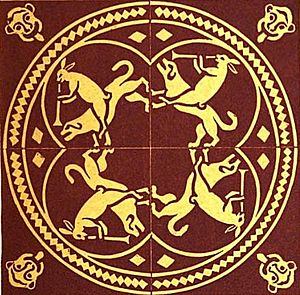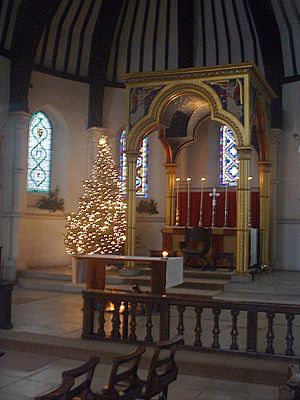Lord of Misrule facts for kids

In England, the Lord of Misrule – known in Scotland as the Abbot of Unreason and in France as the Prince des Sots – was an officer appointed by lot during Christmastide to preside over the Feast of Fools. The Lord of Misrule was generally a peasant or sub-deacon appointed to be in charge of Christmas revelries.
The Church in England held a similar festival involving a boy bishop. This custom was abolished by Henry VIII in 1541, restored by the Catholic Mary I and again abolished by Protestant Elizabeth I, though here and there it lingered on for some time longer. On the Continent it was suppressed by the Council of Basel in 1431, but was revived in some places from time to time, even as late as the eighteenth century. In the Tudor period, the Lord of Misrule (sometimes called the Abbot of Misrule or the King of Misrule) is mentioned a number of times by contemporary documents referring to revels both at court and among the ordinary people.
While mostly known as a British holiday custom, some folklorists, such as James Frazer and Mikhail Bakhtin, have claimed that the appointment of a Lord of Misrule comes from a similar custom practised during the Roman celebration of Saturnalia. In ancient Rome, from 17 to 23 December (in the Julian calendar), a man chosen to be a mock king was appointed for the feast of Saturnalia, in the guise of the Roman deity Saturn. This hypothesis has been heavily criticized by William Warde Fowler, who claims that, despite the frequency with which Christian traditions arise directly from re-framings of the customs of antiquity, the Christmas custom of the Lord of Misrule during the Christian era and the Saturnalian custom of antiquity may have completely separate origins; the two separate customs, however, can be compared and contrasted.
History
Ancient Rome
On 1 January, AD 400, the bishop Asterius of Amasea in Pontus (modern Amasya, Turkey) preached a sermon against the Feast of Calends ("this foolish and harmful delight") that describes the role of the mock king in Late Antiquity. The New Year's feast included children arriving at each doorstep, exchanging their gifts for reward:
This festival teaches even the little children, artless and simple, to be greedy, and accustoms them to go from house to house and to offer novel gifts, fruits covered with silver tinsel. For these they receive, in return, gifts double their value, and thus the tender minds of the young begin to be impressed with that which is commercial and sordid.
—Asterius, in "Oratio 4: Adversus Kalendarum Festum"
It contrasted with the Christian celebration held, not by chance, on the adjoining day:
We celebrate the birth of Christ, since at this time God manifested himself in the flesh. We celebrate the Feast of Lights (Epiphany), since by the forgiveness of our sins we are led forth from the dark prison of our former life into a life of light and uprightness.
—Asterius, "Oratio 4"
Significantly, for Asterius the Christian feast was explicitly an entry from darkness into light, and although no conscious solar nature could have been expressed, it is certainly the renewed light at midwinter that was celebrated among Roman pagans, officially from the time of Aurelian, as the "festival of the birth of the Unconquered Sun". Meanwhile, throughout the city of Amasea, although entry into the temples and holy places had been forbidden by the decree of Theodosius I (391), the festival of gift-giving when "all is noise and tumult" in "a rejoicing over the new year" with a kiss and the gift of a coin, went on all around, to the intense disgust and scorn of the bishop:
This is misnamed a feast, being full of annoyance; since going out-of-doors is burdensome, and staying within doors is not undisturbed. For the common vagrants and the jugglers of the stage, dividing themselves into squads and hordes, hang about every house. The gates of public officials they besiege with especial persistence, actually shouting and clapping their hands until he that is beleaguered within, exhausted, throws out to them whatever money he has and even what is not his own. And these mendicants going from door to door follow one after another, and, until late in the evening, there is no relief from this nuisance. For crowd succeeds crowd, and shout, shout, and loss, loss.
—Asterius, "Oratio 4"
However, according to the anthropologist James Frazer, there was a darker side to the Saturnalia festival. In Durostorum on the Danube (modern Silistra), Roman soldiers would choose a man from among them to be the Lord of Misrule for thirty days. At the end of that thirty days, he was sacrificed on the altar of Saturn. Similar origins of the British Lord of Misrule, as a sacrificial king (a "temporary king", as Frazer puts it) who was later put to death for the benefit of all, have also been recorded.
References to Frazer's view of this ancient sacrifice were made in the 1973 film The Wicker Man.
While the later Roman custom of a Lord of Misrule as a master of revels, a figure of fun and no more than that, is most familiar, there does seem to be some indication of an earlier and more unpleasant aspect to this figure. Frazer recounts:
We are justified in assuming that in an earlier and more barbarous age it was the universal practice in ancient Italy, wherever the worship of Saturn prevailed, to choose a man who played the part and enjoyed all the traditionary privileges of Saturn for a season, and then died, whether by his own or another's hand, whether by the knife or the fire or on the gallows-tree, in the character of the good god who gave his life for the world.
Tudor England

In the Tudor period, John Stow in his Survey of London, published in 1603, gives a description of the Lord of Misrule:
[I]n the feaste of Christmas, there was in the kinges house, wheresoeuer hee was lodged, a Lord of Misrule, or Maister of merry disports, and the like had yee in the house of euery noble man, of honor, or good worshippe, were he spirituall or temporall. Amongst the which the Mayor of London, and eyther of the shiriffes had their seuerall Lordes of Misrule, euer contending without quarrell or offence, who should make the rarest pastimes to delight the Beholders. These Lordes beginning their rule on Alhollon Eue [Halloween], continued the same till the morrow after the Feast of the Purification, commonlie called Candlemas day: In all which space there were fine and subtle disguisinges, Maskes and Mummeries, with playing at Cardes for Counters, Nayles and pointes in euery house, more for pastimes then for gaine.
Decline of the custom in Britain

With the rise of the Puritan party in the 17th century Church of England, the custom of the Lord of Misrule was outlawed as it was deemed "disruptive"; even after the Restoration, the custom remained banned and soon became forgotten. In the early 19th century, the Oxford Movement in the Anglican Church ushered in "the development of richer and more symbolic forms of worship, the building of neo-Gothic churches, and the revival and increasing centrality of the keeping of Christmas itself as a Christian festival" as well as "special charities for the poor" in addition to "special services and musical events". Charles Dickens and other writers helped in this revival of the holiday by "changing consciousness of Christmas and the way in which it was celebrated" as they emphasized family, religion, gift-giving, and social reconciliation as opposed to the historic revelry common in some places.
See also

